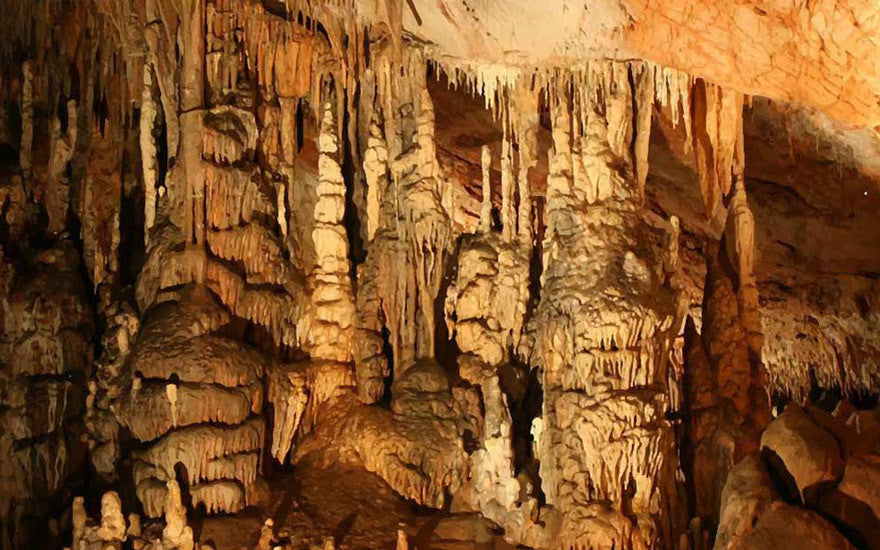The Caverns of Creation

In the first episode of The Adventure Begins, Dr. Kendall Park and Jonathan discover a hidden limestone cave while running from a fierce storm. Although the cave that Jonathan discovered is fictitious, many limestone caves can be found in the U.S. and other parts of the world. One of the most remarkable caves is located in southeastern New Mexico, not too far from Jonathan Park’s discovery. This limestone cave (or cavern if it’s a large cave) is called the Carlsbad Caverns.
Listen to Jonathan and Jessie explore the limestone cave on the Brenan Ranch:
So how are limestone caverns formed?
Limestone is primarily composed of the mineral calcite (calcium carbonate). When rainwater falls through the atmosphere and seeps through the ground’s soil, it picks up carbon dioxide, which turns the water acidic. The slightly acidic water reacts with the calcite in the limestone, and with the help of underground streams, the limestone is dissolved and removed leaving vast openings under the earth’s surface (caves and caverns). Some limestone caves are not formed by carbonic acid, but rather by sulfuric acid. Sulfuric acid is much more powerful and dissolves the limestone more quickly.
Different cave formations:
The Carlsbad Caverns as well as so many other caves contain incredible speleothems (mineral deposits that lead to cave formations). The two common speleothems are stalactites (icicle-like formations that suspend from the cave’s ceiling) and stalagmites (formations that are built from the ground up).

It’s easy to confuse the two, so here’s a trick: stalactites fasten “tite” to the cave’s ceiling! “Stalagmite” has the letter G in it – G for ground! When a stalactite and a stalagmite meet in the middle, they form a column. Other speleothems include soda straws, helicities, draperies, and flowstones.

How long does it take to form a cavern?
If you ask an evolutionary geologist, he’ll most likely tell you that it takes millions of years to form a large cavern. Here is a common evolutionary reasoning: Hundreds of millions of years ago, hard-shelled marine creatures died and piled up on the ocean floor. Their carcasses eventually amassed to hundreds of feet of limestone. Acidic water, over the course of millions of years, would erode the limestone, creating caves. The evolutionists make a generous assumption when they claim that the modern day cave formation rate would be the same as when these caves were originally formed.
Both Creationists and Evolutionists recognize that serious amounts of water are needed to lay down limestone layers as evidenced in most of the major limestone formations. They also recognize that these formations contain large amounts of the mineral calcite (i.e. found in fossils). The Creationist Geologists look to Noah’s flood as a probable source for the need of copious amounts of water and fossils to form limestone caves. Specifically, Creationists look to Genesis 7:11 for insight on the subject, which describes the “fountains of the deep” breaking up. They understand that this event would literally require enormous underwater volcanic explosions that pushed lime-rich sentiment all over the sea and once dry land. These fractured layers would then be rapidly buried by organic matter, likely trapping vast of amounts of water in between the limestone layers. This trapping of water would keep the limestone from completely hardening until tectonic shifts forced the layers closer to the earth’s surface and under the immense pressure, squeezed the water from the layers. This water would have dispersed through the newly formed cracks and channels caused by the tectonic shifts. This lime-rich, volcanic water would have mixed with the hydrogen sulfide (released by tectonic activity and decaying organic matter on the once dry land) to create a rapid limestone eating sulfuric acid. In this extreme acidic environment, limestone would have been quickly eaten away. When considering the effects of a global Flood on the earth, it’s reasonable to conclude that limestone caves could have formed in a timeline that is consistent with the Bible.
Listen to Jonathan and Jessie explore the cave’s cathedral room:
Interesting Note: ‘From 1924 to 1988, there was a visitor’s sign above the entrance to Carlsbad Caverns that said Carlsbad was at least 260 million years old. In 1988, the sign was changed to read 7 to 10 million years old. Then, for a little while, the sign read that it was 2 million years old. Now the sign is gone.’ In short, geologists don’t really know how long cave formation takes.
Jerry Trout (cave specialist with the Forest Service), ‘Descent,’ Arizona Highways, January 1993, pp. 10–11.
Leave a comment
Comments will be approved before showing up.



